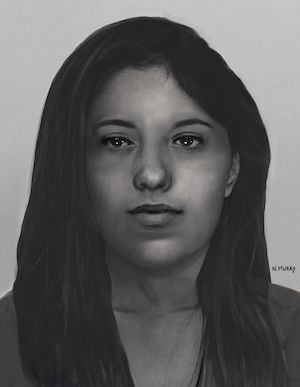Summary
In September 1968, the remains of an unidentified woman were found by a highway department worker while on assignment near Blodgett Road in unincorporated Will County, Illinois. Will County is part of the Chicago metropolitan area, located south and southwest of downtown Chicago. The woman's body was found despite being partially covered by brush from a nearby tree. The Will County Sheriff's Police Department responded and began investigating.
There was no identification, clothing or jewelry found on or near the remains. The unidentified nude woman was 5’5” tall and weighed 135 pounds. She had straight, collar-length hair with color ranging from red to medium brown, and some graying roots indicating that her hair was dyed. The unknown woman had brown eyes and both of her ears were pierced. An autopsy was performed by the Will County Coroner's Office, which determined that the woman had been strangled and sustained blunt force trauma to the head. Fingerprints were obtained by investigators at the autopsy, but the prints did not lead to the identity of the woman. DNA analysis was not available in 1968, but a blood sample was tested and indicated that she had type O blood.
Despite a lengthy investigation, the woman could not be identified and the case went cold. She was buried in Oakwood Cemetery in Wilmington, Illinois. Details of the case were entered into the National Missing and Unidentified Persons System (NamUs) as UP5211.
In 2008 then-Will County Coroner Patrick K. O’Neil created a part-time cold case unit. This unit had investigated leads in this case along with investigators with the Will County Sheriff’s Office. In 2009, the unknown woman's remains were exhumed to obtain a DNA sample and sent to the University of North Texas and later to the Smithsonian Institute Paleontology section. While it was determined that the woman may have been Native American, her identity was still a mystery. Further studies in 2017 at University of Illinois Forensic Anthropology Department indicated the woman Asian ancestry and/or Native American ancestry. 
In 2020, newly-elected Coroner Laurie H. Summers made it a priority to utilize new emerging technologies along with traditional investigative techniques with the current Cold Case investigation being led by retired investigators Joseph Piper and William Sheehan from Lockport, Illinois. A forensic sketch of the what the woman may have looked like was created and distributed, and it was also uploaded to NamUs in 2020.
In 2021, the Will County Coroner's Office, as part of an ongoing collaboration with Othram, submitted forensic evidence to Othram's lab. Othram's scientists were able to extract a DNA sample from this evidence and used Forensic-Grade Genome Sequencing® to build a comprehensive DNA profile. Othram's in-house forensic genetic genealogy team used the profile in a genetic genealogy search to develop new investigative leads that were returned to law enforcement. Using this new information, a follow-up investigation was conducted leading investigators to Native American tribes in Illinois, Wisconsin, Minnesota, and Iowa, inquiring about any missing person reports from the late 1960s that matched the victim’s description.
Cooperation with the Bureau of Indian Affairs was instrumental, and they were able to create and disseminate a flyer that was published on social media and distributed within Native communities. This outreach led to a woman in Washington who believed she was a distant relative of the unknown woman. The woman in Washington was able to make contact with a niece who provided a reference DNA sample to compare to the DNA profile of the unknown woman using KinSNP® Rapid Relationship Testing. This investigation led to the positive identification of the woman, who is now known to be Martha Bassett, who was 33 years old when she was killed.
Martha Bassett was born in Washington and was a member of the Native American community from Wapato, in Yakima County, Washington. In 1960, she relocated to the Chicago area as part of the Indian Relocation Act of 1956, a federal initiative that sought to encourage Indigenous peoples to move from reservations to urban centers. By 1967, Martha lost contact with her family, who were concerned for her welfare. They traveled to Chicago in an effort to find her, but their search was fruitless and they returned home without answers.
Funding for the advanced DNA testing and forensic genetic genealogy used in this case was provided by NamUs, a national clearinghouse that assists the criminal justice community with the investigation and resolution of missing, unidentified, and unclaimed persons cases across the United States and its territories. NamUs is funded and administered by the National Institute of Justice (NIJ) and is managed through a contract with Research Triangle Institute International. We are grateful for the support of RTI, NamUs, and the NIJ.
The identification of Martha Bassett represents the 11th case in the State of Illinois where officials have publicly identified an individual using technology developed by Othram. Othram has been successful in identifying five Will County Coroner Cold Cases since 2022 and has created crowdfunds in an effort to solve at least two others. To see those cases, visit DNASolves.
